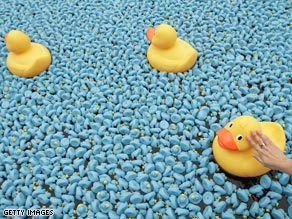Rubber ducks aid NASA study
LONDON, England (CNN) -- As an organization they're used to investing billions of dollars in scientific experiments that further our knowledge of earth and space. But the only bill to speak of on this occasion is orange and attached to the body of a rubber duck.

Scientists from NASA hope that rubber ducks will help them better understand glacier movements.
In the name of climate change science, researchers at NASA have dropped 90 rubber ducks into holes of Greenland's fastest moving glacier: the Jakobshavn Glacier in Baffin Bay.
Scientists remain unsure as to why glaciers speed up their movement in the summer months and it is hoped that the rubber ducks -- labeled with the words "science experiment" and "reward" in three languages, along with an email address -- will shed some light on the phenomenon.
One theory is that the summer sun melts ice on the surface of the glacier which creates pools of water which then flow into moulins -- narrow tubular shafts in the glacier. These then transport the water from the top to the underside of the glacier.
It's thought that this base water acts as a lubricant to speed up the movement of the glacier towards the sea. more>>










No comments:
Post a Comment